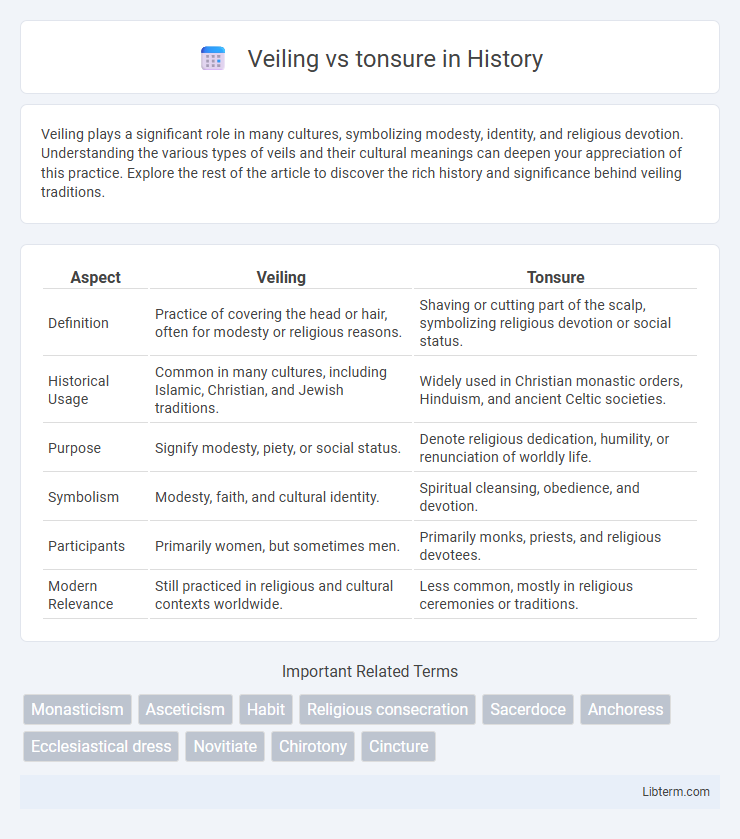Veiling plays a significant role in many cultures, symbolizing modesty, identity, and religious devotion. Understanding the various types of veils and their cultural meanings can deepen your appreciation of this practice. Explore the rest of the article to discover the rich history and significance behind veiling traditions.
Table of Comparison
| Aspect | Veiling | Tonsure |
|---|---|---|
| Definition | Practice of covering the head or hair, often for modesty or religious reasons. | Shaving or cutting part of the scalp, symbolizing religious devotion or social status. |
| Historical Usage | Common in many cultures, including Islamic, Christian, and Jewish traditions. | Widely used in Christian monastic orders, Hinduism, and ancient Celtic societies. |
| Purpose | Signify modesty, piety, or social status. | Denote religious dedication, humility, or renunciation of worldly life. |
| Symbolism | Modesty, faith, and cultural identity. | Spiritual cleansing, obedience, and devotion. |
| Participants | Primarily women, but sometimes men. | Primarily monks, priests, and religious devotees. |
| Modern Relevance | Still practiced in religious and cultural contexts worldwide. | Less common, mostly in religious ceremonies or traditions. |
Introduction to Veiling and Tonsure
Veiling typically refers to the practice of covering the head or face with a cloth as a sign of modesty or religious observance, prevalent in various cultures and faiths such as Islam and Orthodox Christianity. Tonsure involves the shaving or cutting of hair on the scalp, often symbolizing religious devotion or monastic commitment, most notably in Christian monastic traditions. Both veiling and tonsure serve as visible markers of identity and spirituality, reflecting deeply rooted cultural and religious values.
Historical Origins of Veiling and Tonsure
Veiling has roots in ancient Mesopotamian and Greco-Roman cultures where it symbolized modesty and social status, evolving through religious and cultural contexts in Islam, Christianity, and Judaism. Tonsure, originating in early Christian monastic traditions around the 6th century, served as a visible sign of religious devotion and clerical identity, initially practiced by Celtic and Benedictine monks. Both practices reflect deep historical connections to identity, authority, and spiritual discipline across different civilizations.
Cultural Significance of Veiling
Veiling holds profound cultural significance across various societies as a symbol of modesty, social identity, and religious devotion, reflecting diverse customs and traditions from the Middle East to South Asia. Unlike tonsure, which primarily serves as a rite of initiation or spiritual discipline in religious contexts, veiling embodies complex social roles and gender norms that are deeply embedded in cultural heritage. This practice continues to influence community interactions, status, and individual expression, marking its enduring importance in cultural and religious frameworks worldwide.
Religious Meanings Behind Tonsure
Tonsure symbolizes religious devotion and humility, marking a visible commitment to spiritual life across various faith traditions, including Christianity, Buddhism, and Hinduism. The practice of tonsure involves the deliberate shaving or cutting of hair to signify renunciation of worldly vanity and submission to divine authority. In contrast, veiling primarily represents modesty, privacy, and sometimes social status, but lacks the explicit sacrificial and consecratory connotations inherent in tonsure.
Veiling Practices Across Different Cultures
Veiling practices vary significantly worldwide, reflecting diverse cultural, religious, and social meanings; for example, Muslim women often wear the hijab as a symbol of modesty and faith, while in Hindu culture, the ghoonghat signifies respect and tradition. In some African societies, veils serve both protective and ceremonial purposes, integrating local customs with identity expression. These variations highlight veiling as a multifaceted practice deeply embedded in cultural heritage and spiritual beliefs.
Rituals and Symbolism of Tonsure
Tonsure represents a ritualistic shaving or cutting of hair symbolizing religious devotion, humility, and renunciation of worldly vanity, prominently practiced in monastic communities across Christianity, Hinduism, and Buddhism. The practice signifies spiritual cleansing, rebirth, and a commitment to a sacred path, often reflecting a transformative rite of passage or initiation. Unlike veiling, which emphasizes modesty and social identity, tonsure serves as a visible marker of religious dedication and inner purification.
Gender Perspectives: Women and Veiling, Men and Tonsure
Veiling and tonsure represent distinct gendered cultural practices with veiling primarily associated with women as a symbol of modesty and religious devotion, while tonsure is often a male ritual signifying spiritual dedication or monastic commitment. Women's veiling practices vary across societies, reflecting diverse interpretations of femininity, piety, and social identity, whereas men's tonsure typically marks entry into religious orders or spiritual renunciation. These gender-specific customs reveal broader social norms and power dynamics related to religious expression and gender roles in different cultural contexts.
Modern Interpretations and Controversies
Modern interpretations of veiling often frame it as an expression of cultural identity, personal faith, or feminist empowerment, whereas tonsure is largely seen as a traditional monastic practice symbolizing religious devotion and humility. Contemporary controversies around veiling involve debates over women's rights, secularism, and freedom of expression, while tonsure controversies center more on cultural preservation versus modernization within religious communities. The veiling discourse is highly politicized and visible in public policy and social movements, contrasting with the more localized and symbolic debates surrounding tonsure.
Social Impact of Veiling and Tonsure
Veiling and tonsure serve as powerful social symbols within various cultures, influencing identity and community belonging. Veiling often reflects social norms, gender roles, and religious adherence, impacting women's visibility and societal participation. Tonsure, traditionally linked to religious devotion, can denote spiritual status and communal acceptance, affecting social hierarchy and group inclusion.
Conclusion: Comparing Veiling and Tonsure Traditions
Veiling and tonsure represent distinct cultural and religious expressions with veiling primarily signifying modesty and identity in various faiths, while tonsure involves shaving the head as a symbol of renunciation or spiritual devotion. Both practices communicate deep religious commitment but differ in physical manifestation and gender associations, with veiling often linked to women and tonsure to male monastic life. Understanding these traditions highlights the diverse ways physical appearance is used to convey faith and social roles across cultures.
Veiling Infographic

 libterm.com
libterm.com